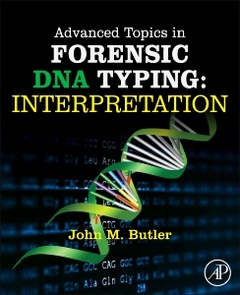Description
Advanced Topics in Forensic DNA Typing: Interpretation
Author: Butler John M.
Language: English
Subject for Advanced Topics in Forensic DNA Typing: Interpretation:
Keywords
2p Rule; ABI Genetic Analyzer; Administrative review; Allele Drop-In; Allele Drop-Out; Allele Dropout; Allele Frequencies; Allelic Ladder; Analytical Threshold; Assumptions; Binary Method; CPI/CPE; Capillary electrophoresis; Casework reports; Combined Probability Of Exclusion; Combined Probability Of Inclusion; Communication; Complex Mixture; Complex Mixtures; Component Deconvolution; Concordance Study; Confidence Intervals; DNA Mixture; DNA Profile; Data Collection; Data Interpretation; Data Models; Disaster Victim Identification; Drawing conclusions; Dye Color Balance; Electrokinetic injection; Electropherogram; Familial Searching; Fluorescence detection; Fully Continuous Method; Haploid Markers; Hardy-Weinberg Equilibrium; Hypothesis Testing; ISFG DNA Commission; ISFG Recommendations; Immigration Testing; Kinship Analysis; Kit Validation Studies; LCN; LTDNA; Likelihood Ratio; Lineage Markers; Linkage Disequilibrium; Locus-To-Locus Balance; Low-Level DNA; Low-Template DNA; Major Contributor; Match Probability; Minor Contributor; Missing Persons Investigations; Mitochondrial DNA; Mixture; Mixture Deconvolution; Modified Random Match Probability (mRMP); Noise; Non-Template Addition; Null Allele; PCR Multiplex Reactions; PCR artifacts; Parentage Testing; Partial Profile; Peak Height Ratio; Population Database; Population Substructure; Probabilistic Genotyping; Probability; Product Rule; Profile Frequency; Random Man Not Excluded (RMNE); Random Match Probability; Relationship Testing; Relatives; Report writing; Restricted vs; STR Allele; STR Genotype; STR Profiles; STR Typing; Semi-Continuous Method; Sibship Testing; Signal; Size Standard; Source Attribution; Standard Operating Procedure (SOP); Statistics; Stochastic Threshold; Stutter Product; Technical review; Threshold; Tri-Allelic Patterns; Troubleshooting; Unrestricted Genotype Combinations; Validation; Validation Data; Variant Allele; Weight-of-Evidence; X-Chromosome; Y-Chromosome
608 p. · 19x23.4 cm · Hardback
Description
/li>Contents
/li>Readership
/li>Biography
/li>Comment
/li>
Advanced Topics in Forensic DNA Typing: Interpretation builds upon the previous two editions of John Butler?s internationally acclaimed Forensic DNA Typing textbook with forensic DNA analysts as its primary audience. Intended as a third-edition companion to the Fundamentals of Forensic DNA Typing volume published in 2010 and Advanced Topics in Forensic DNA Typing: Methodology published in 2012, this book contains 16 chapters with 4 appendices providing up-to-date coverage of essential topics in this important field. Over 80 % of the content of this book is new compared to previous editions.
Section 1: DATA INTERPRETATION Chapter 1: Data Interpretation Overview Chapter 2: Data, Models & Thresholds Chapter 3: STR Alleles & Artifacts Chapter 4: STR Genotypes Chapter 5: STR Profiles Chapter 6: DNA Mixtures Chapter 7: Low-Level DNA & Complex Mixtures Chapter 8: Troubleshooting Data Collection
Section 2: STATISTICAL INTERPRETATION Chapter 9: Statistical Interpretation Overview Chapter 10: STR Population Data Analysis Chapter 11: DNA Profile Frequency Estimates Chapter 12: DNA Mixture Statistics Chapter 13: Coping with Missing Alleles Chapter 14: Relationship Testing Chapter 15: Lineage Marker Statistics Chapter 16: Laboratory Reports: Communicating Results and Conclusions
APPENDICES Appendix 1: STR Allele Frequencies from U.S. Population Data Appendix 2: NRC I and NRC II Recommendations Appendix 3: DAB Recommendations on Statistics Appendix 4: Worked mixture example (by Dr. Michael D. Coble)
Researchers and practitioners in forensic DNA analysis, forensic scientists; legal professionals, military, private and public forensic laboratories, forensic science graduate and post-graduate students.
- Provides forensic DNA analysts coverage of the crucial topic of DNA mixture interpretation and statistical analysis of DNA evidence
- Worked mixture examples illustrate the impact of different statistical approaches for reporting results
- Includes allele frequencies for 24 commonly used autosomal STR loci, the revised Quality Assurance Standards which went into effect September 2011
These books may interest you

DiMaio's Forensic Pathology 148.11 €



